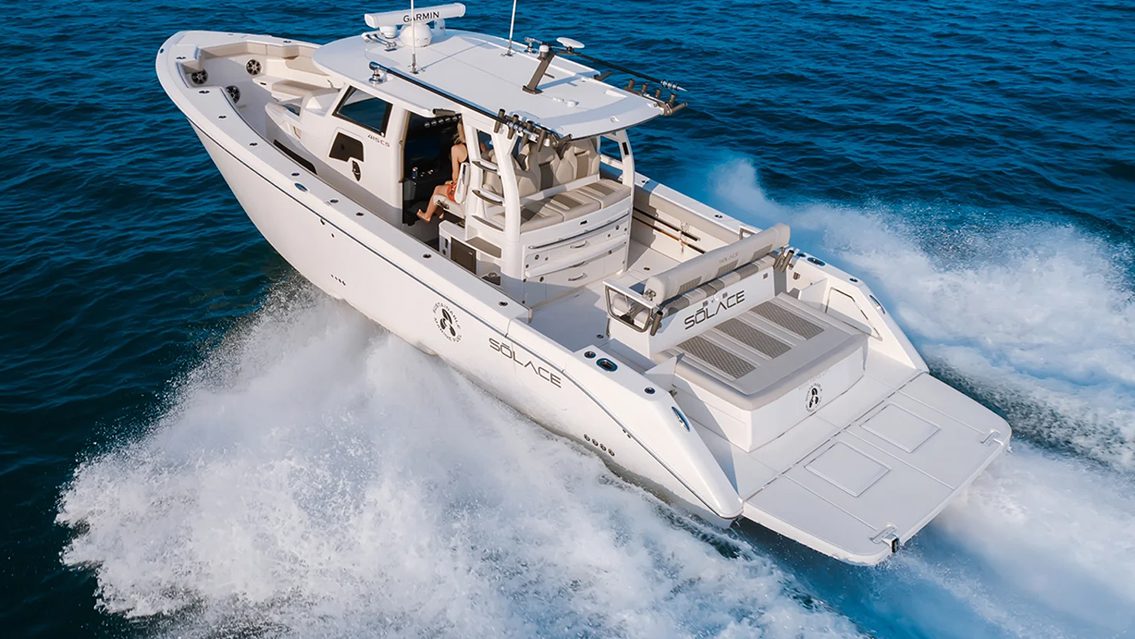Here’s why the Volvo Penta DPI Aquamatic has become a strong alternative to outboard power on luxury day boats.
![]()
Charles Plueddeman
A brace of outboards is the most popular power choice for the current generation of large center console models, day boats and sport cruisers, but it is no longer the only choice. Volvo Penta is making a strong case for its DPI Aquamatic D6-440 as an alternative to outboard power, and a number of production boat builders now offer this diesel sterndrive powertrain for boats ranging in size from about 42 to 56 feet in length. They’re adding the Aquamatic to the list of power options for select models because the diesel sterndrive offers significantly better fuel economy and more range than outboards at a similar cruising speed. Outboards will still deliver more top speed, but many experienced boat owners have learned that conditions don’t always permit running at wide-open throttle.
Solace Boats of Florida, is one company offering a diesel sterndrive option. The builder refit its 41 CS—a 41-foot center console originally designed for Mercury or Yamaha outboards—to accommodate Volvo’s DPI Aquamatic. That boat is called the 415CS.
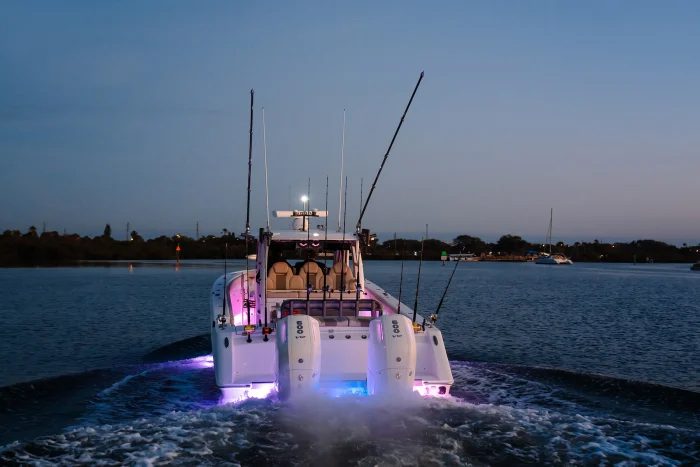
The Solace is also offered with outboards as the 41CS.
“In our 415CS, the DPI Aquamatic’s combination of diesel torque and large dual propellers makes the boat feel like a big inboard sportfish,” says Solace CEO Stephen Dougherty. “There’s authority at the controls that gives the captain a real sense of command. You can cruise at 45 mph and these engines are just loafing. And we’ve seen fuel costs cut in half on runs to the Bahamas.”
In a similar move, MJM Yachts of North Carolina now offers its 46-foot, 8-inch MJM 4 Carolina Downeast-style day yacht with twin Mercury 600 Verado outboards or twin DPI Aquamatics. It will offer the same options on its new MJM 42 liveaboard performance yacht.
“There are boat owners who really love the look of a row of big outboards on the transom,” says Chris Hughes of MJM Yachts, “but I think many are reconsidering outboards now. They can highjack the boat design. People are realizing many of the old objections to sterndrives in salt water are out of date. Volvo offers outstanding corrosion resistance features. In fact, we don’t even call this option a sterndrive. It’s the DPI Advanced Drive system. There’s no comparison to products offered in the past, including pod drives, which are excellent but not an option for boaters who want to beach or get into skinny water. DPI Advanced Drive combines the efficiency and reliability of diesel power with the trim function of an outdrive and gives the customer an open transom with a platform for a tender.”
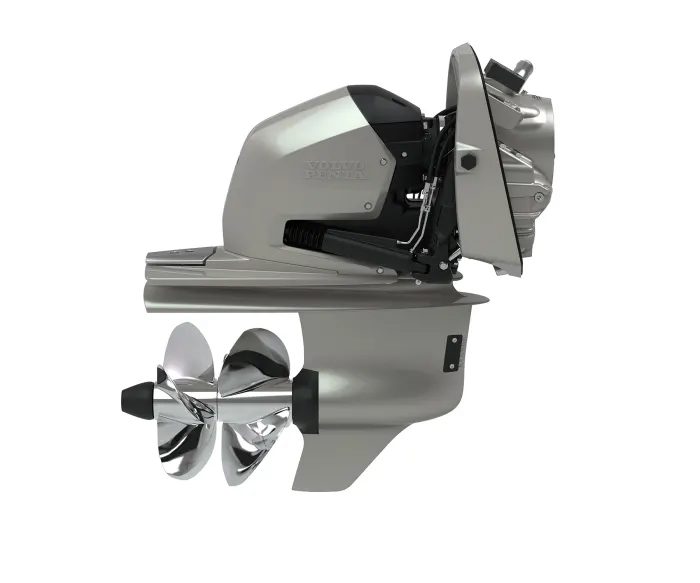
The original intention of the sterndrive—Volvo Penta introduced its first Aquamatic 100 in 1959, and Kiekhaefer Mercury countered in 1961 with its MerCruiser sterndrive—was to pair an inboard engine with a steerable transom-mounted outdrive in a package that offered more power than outboards. By the mid-1960s, sterndrives up to 300 horsepower offered three times the power of any contemporary outboard. Today, outboard power matches or exceeds that of standard gas sterndrives, and that power can be multiplied by placing four to six powerful outboards on the transom of large boats.
The Volvo Penta DPI Aquamatic drive was introduced in 2019 specifically to compete with multi-engine outboards on the new breed of large, premium-priced, high-speed boats. By pairing this robust drive with its diesel engines up to the 5.5-liter, 440-horsepower D6, a boat builder can offer the advantages of diesel power, trimmable outdrives and a clear transom, all with acceptable performance. Right now Volvo Penta alone offers this option because Mercury Marine does not match a MerCruiser Bravo drive with its 6.7-liter diesel engines.
The DPI Aquamatic features a smooth-shifting hydraulic clutch that’s designed to slip at low engine speeds to reduce boat speed when docking or trolling, plus all the modern bells and whistles, including Electronic Vessel Control (EVC), auto trim, joystick control, Dynamic Positioning System and Assisted Docking for multi-engine installations. The drive utilizes many of the robust internal components designed for the Volvo Penta IPS pod drive plus the latest alloys, finishes and isolated prop sets to further fight saltwater corrosion. In addition, it can be equipped with Active Corrosion Protection—sensors warn of water in the engine oil and the drive bellows. Contra-rotating Duoprop props are stainless steel, three-blade front and four-blade rear, to maximize blade area and thrust.
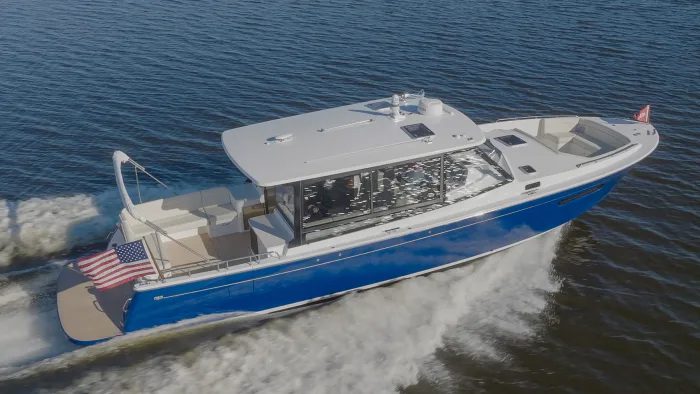
The MJM 4 was first designed for outboards; it’s now offered with diesel sterndrives.
Of course, many boat owners know that outboard power offers a number of advantages over an inboard system, be it sterndrive, pod drive or straight inboard. The engines are exposed for service and are easy to replace. Placing the engines on the transom frees up space within the boat. Outboards are lighter in weight than inboard engines and today can offer from 400 to 600 horsepower each. It’s that level of power that’s enabled the design of ever larger and faster day boats for fishing and cruising.
Those are the key benefits of outboard power. Outboard detractors usually site the complexity of rigging and maintaining multiple outboards, the fact that outboards occupy the transom, and just the aesthetics of a rack of big outboards on the stern of an otherwise sleek boat.
From a performance standpoint, the DPI Aquamatic offers the advantage of tremendous torque and desirable weight distribution. Abundant torque enables the swinging of large, paired props that can lift a heavy boat smartly on plane and hold it there at lower boat speed. Torque also produces that throttle authority Dougherty spoke of. The D6-440 engine peaks at about 774 lb. ft. of torque and maintains that level from 2000 to 3000 rpm, or most of its cruising range. Outboard manufacturers do not publish torque ratings, but let’s consider the 6.2-liter V8 gas engine Volvo Penta offers with a 430-hp rating. It makes about 435 lb. ft. of torque at 4200 rpm, a 78 percent advantage for the diesel. At 2000 rpm the diesel makes twice the torque of the gas engine. This is the nature of diesel power, and one reason it’s so attractive for larger boats.
All this torque is produced with great economy and lower emissions. Fuel economy for the Aquamatic DPI is 30 to 67 percent better at cruising speeds than the available Mercury Verado outboard options in performance data for the MJM and Solace models. And, according to Arjen Steegstra, director of marine leisure at Volvo Penta, the DPI Aquamatic system produced 30 times less CO2 emissions than a four-stroke outboard of comparable power.
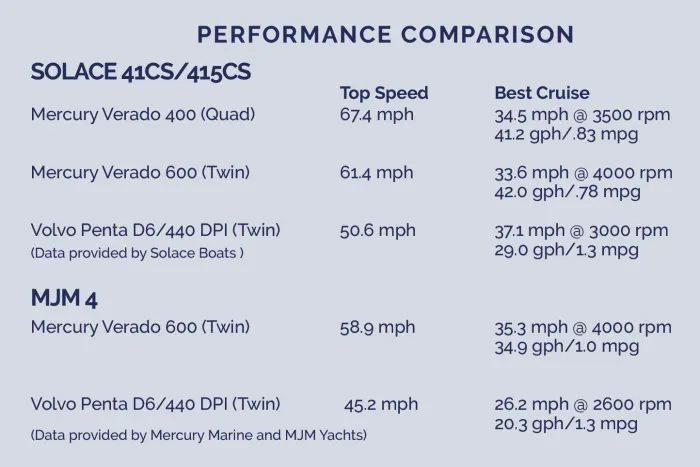
At about 3,520 pounds (dry weight), a twin DPI Aquamatic system weighs quite a bit more than most popular outboard options. A pair of Mercury 600 Verado outboards weighs about 2,600 pounds, while quad Mercury 400 Verado outboards weigh about 2,800 pounds. However, all of the outboard weight is beyond the transom where it exerts considerable leverage on the boat, while most of the weight of the DPI Aquamatic system, 1,400 pounds for each engine, is located within the boat. This can have a dramatic effect on seakeeping in less-than-calm conditions, as with that weight forward the boat will pitch less.
“We ran our first sterndrive-powered 415CS and an outboard-powered 41CS from Florida to the Abacos and encountered 8-foot seas, 20 feet apart,” says Dougherty. “We made much better time in the diesel-powered boat because we could run faster without beating up the crew. On the return we lost sight of the other boat and stopped to wait on several occasions. The 41CS is a very capable boat, but in this situation the 415CS was more comfortable.”
Volvo Penta offers jack shaft options that permit rigging the DPI Aquamatic system with the engine some distance forward of the transom, if the boat builder determines that will improve the balance of the boat. The ability to locate the engines forward also enables a parallel hybrid system Volvo Penta is now testing in collaboration with Groupe Beneteau using a Jeanneau NC 37. The electric motor fits between the engine and outdrive, and the boat can make way under either diesel or electric power, or a combination of both power sources. This system may be ready for pre-production testing in 2025.
The transom is clear of outboard clutter on a boat powered by the DPI Aquamatic system. This allows the Solace 415CS, for example, to feature a 4-foot deep, full-width swim platform and a convertible lounge/aft seat with an unobstructed view off the stern of the boat. The trade-off is a motorbox about 10 inches high that does take up deck space in the cockpit, over which Solace has placed that aft seat. On the MJM 4 the engines fit below the sole, so there is no difference in cockpit deck space with outboard or DPI Aquamatic power. The engines do take up space below deck that would otherwise be available for stowage, mechanical systems or fuel. As a result a smaller fuel tank is fitted to Solace and MJM models with DPI Aquamatics. Of course, the diesel boat doesn’t need to carry as much fuel.
There is no question a pair of Mercury 600 Verado outboards is less expensive than the Volvo Penta DPI Aquamatic. The MJM 4 is priced about $95,000 higher with DPI Aquamatic power ($1,914,000 to $2,009,000), while a base price for the Solace 415CS is $172,000 higher than the outboard-powered Solace 41CS ($1,638,000 to $1,810,000).
Expect more builders to offer a choice of outboard or DPI Aquamatic power. In 2022, Southport Boats converted one of its 30 FE center console models from twin outboard to a single DPI Aquamatic D6-440. Volvo Penta used the boat to showcase its new joystick control system for single-engine boats, but the build also attracted the attention of potential Southport diesel customers. “We’ve had a number of inquiries about a DPI option, so the 30 FE with DPI will be available for order later this year,” said George Menezes, Southport COO. “The economy of a diesel becomes more feasible as the boat gets larger and more expensive, and we are looking at adding that option on a new 38 dual console and a 42 we have on the board.”
Boston Boatworks offers its 44 and 52 Offshore Express Cruiser models exclusively with DPI Aquamatic power. Volvo Penta recently announced the availability of a DPI Aquamatic triple installation for commercial and leisure boats. One of the first installations is in a 48-foot aluminum patrol boat made in Sweden.
Count Stephen Dougherty, a real veteran of the industry, among the converted. “Volvo Penta was after us to build a Solace 41 with the DPI Aquamatic power for some time, and I kept saying no, no, no,” he said. “It would be a big job to install that system and I had no faith it would perform well. We did not design the boat for this power. We finally relented and built the prototype, and wow. This is a pretty cool boat.”
This article was originally published in the April 2024 issue.

